Overview and Recent Developments
Since assuming the throne from his late father on February 7, 1999, Jordan's 57-year-old monarch King Abdullah II bin Al Hussein (hereinafter King Abdullah II) has maintained Jordan's stability and strong ties to the United States.
Although commentators frequently caution that Jordan's stability is fragile, the monarchy has remained resilient owing to a number of factors. These include a strong sense of social cohesion, strong support for the government from both Western powers and the Gulf Arab monarchies, and an internal security apparatus that is highly capable and, according to human rights groups, uses vague and broad criminal provisions in the legal system to dissuade dissent.1
Despite this resilience, Jordanians are becoming increasingly restless over economic conditions, corruption, and lack of political reform.2 In 2018, real GDP growth was 2.8%, while unemployment stood at 18.5%, and was likely much higher among young workers.3 Publicized allegations of high-level corruption include cases against several private- and public-sector elites for conspiring to illegally manufacture cigarettes. Weekly protests have been recurring in Amman, though they have not been as large as summer 2018 protests over tax hikes. Additionally, many Jordanians have turned to social media to express their dissatisfaction with the status quo; the kingdom has one of the highest worldwide rates of social media usage among emerging economies.4 According to one former high-ranking Jordanian official, "Loyalty is overwhelming in Jordan but that doesn't mean there are no pockets here and there that are against even the monarchy. And they are negligible, yes, but through social media they will have a ... big voice."5
King Abdullah II and his government have developed a multifaceted approach for responding to public discontent. In recent months, the king has made several public appearances without a security detail, probably in an effort to increase his visibility and interaction with the population.6 After prominent people criticized the response to corruption concerns,7 Jordan decided to televise the trial of those accused in the cigarette scandal mentioned above—a rarity in Jordan's justice system. The government also has withdrawn controversial amendments to the 2015 cybercrime law. According to Jordanian activists and international nongovernmental organizations, the amendments would have seriously curtailed freedom of expression online.8
Jordan may be addressing public discontent and bolstering nationalist sentiment at home by stoking tensions with Israel in support of the Palestinian cause.9 In late 2018, the king announced (via Twitter) that his government would not renew a provision in its 1994 peace treaty with Israel that allowed Israel access to the Jordanian territories of Baqoura and Al Ghumar, which are agricultural areas in northern and southern Jordan, respectively.10 According to one Jordanian commentator, "Domestically, the King's decision is a much-needed shot in the arm for the government at a time when it is facing public pressure over its unpopular economic policies."11
|
Holy Sites in Jerusalem12 Per arrangements with Israel dating back to 1967 (when the Israeli military seized East Jerusalem—including its Old City—from Jordan) and then subsequently confirmed in the 1994 Israeli-Jordanian peace treaty, Israel acknowledges a continuing role for Jordan vis-à-vis Jerusalem's historic Muslim shrines.13 A Jordanian waqf (or Islamic custodial trust) has long administered the Temple Mount (known by Muslims as the Haram al Sharif or Noble Sanctuary) and its holy sites, and this role is key to bolstering the religious legitimacy of the Jordanian royal family's rule. Successive Jordanian monarchs trace their lineage to the Prophet Muhammad. Disputes over Jerusalem that appear to circumscribe King Abdullah II's role as guardian of the Islamic holy sites create a domestic political problem for the King. Jewish worship on the Mount/Haram is prohibited under a long-standing "status quo" arrangement that dates back to the era of Ottoman control before World War I. |
Several months later, Jordan expanded the membership of the Islamic Waqf Council (Islamic custodial trust), which Jordan appoints to oversee the administration of Jerusalem's Temple Mount (known by Muslims as the Haram al Sharif or Noble Sanctuary) and its holy sites. The Islamic Waqf Council, which had been made up of 11 individuals with close ties to the monarchy, was expanded to 18, including several officials from the Palestinian Authority. The newly expanded council immediately defied a 16-year Israeli ban on Muslim worship at the Bab al Rahma building on the Temple Mount. Israel responded by arresting worshippers and activists while also temporarily banning several leaders of the council from accessing the Temple Mount. In March 2019, King Abdullah II spoke in the industrial city of Zarqa, where he stated, "To me, Jerusalem is a red line, and all my people are with me.... No one can pressure Jordan on this matter, and the answer will be no. All Jordanians stand with me on Jerusalem."14
These types of steps for appeasing an increasingly restive public arguably are vital for the government of Jordan, which has limited financial options for addressing discontent.15 Although the government has continued to work with the International Monetary Fund (IMF) on fiscal reforms, public debt has ballooned to 95% of Gross Domestic Product (GDP), and most of the government's budget is dedicated to salaries, pensions, and debt servicing, leaving few additional options to fund public sector job programs.16 King Abdullah II recently traveled to the United Kingdom, where UK officials pledged to partially guarantee a $1.9 billion World Bank loan to Jordan. In summer 2018, Gulf countries pledged $2.5 billion to Jordan in combined grants and loans.
Country Background
Although the United States and Jordan have never been linked by a formal treaty, they have cooperated on a number of regional and international issues for decades. Jordan's small size and lack of major economic resources have made it dependent on aid from Western and various Arab sources. U.S. support, in particular, has helped Jordan deal with serious vulnerabilities, both internal and external. Jordan's geographic position, wedged between Israel, Syria, Iraq, and Saudi Arabia, has made it vulnerable to the strategic designs of its powerful neighbors, but has also given Jordan an important role as a buffer between these countries in their largely adversarial relations with one another.
Jordan, created by colonial powers after World War I, initially consisted of desert or semidesert territory east of the Jordan River, inhabited largely by people of Bedouin tribal background. The establishment of the state of Israel in 1948 brought large numbers of Palestinian refugees to Jordan, which subsequently unilaterally annexed a Palestinian enclave west of the Jordan River known as the West Bank.17 The original "East Bank" Jordanians, though probably no longer a majority in Jordan, remain predominant in the country's political and military establishments and form the bedrock of support for the Jordanian monarchy. Jordanians of Palestinian origin comprise an estimated 55% to 70% of the population and generally tend to gravitate toward the private sector due to their alleged general exclusion from certain public-sector and military positions.18
The Hashemite Royal Family
Jordan is a hereditary constitutional monarchy under the prestigious Hashemite family, which claims descent from the Prophet Muhammad. King Abdullah II (age 57) has ruled the country since 1999, when he succeeded to the throne upon the death of his father, the late King Hussein, after a 47-year reign. Educated largely in Britain and the United States, King Abdullah II had earlier pursued a military career, ultimately serving as commander of Jordan's Special Operations Forces with the rank of major general. The king's son, Prince Hussein bin Abdullah (born in 1994), is the designated crown prince.19
The king appoints a prime minister to head the government and the Council of Ministers (cabinet). On average, Jordanian governments last no more than 15 months before they are dissolved by royal decree. The king also appoints all judges and is commander of the armed forces.
Political System and Key Institutions
The Jordanian constitution, most recently amended in 2016, gives the king broad executive powers. The king appoints the prime minister and may dismiss him or accept his resignation. He also has the sole power to appoint the crown prince, senior military leaders, justices of the constitutional court, and all 75 members of the senate, as well as cabinet ministers. The constitution enables the king to dissolve both houses of parliament and postpone lower house elections for two years.20 The king can circumvent parliament through a constitutional mechanism that allows provisional legislation to be issued by the cabinet when parliament is not sitting or has been dissolved.21 The king also must approve laws before they can take effect, although a two-thirds majority of both houses of parliament can modify legislation. The king also can issue royal decrees, which are not subject to parliamentary scrutiny. The king commands the armed forces, declares war, and ratifies treaties. Finally, Article 195 of the Jordanian Penal Code prohibits insulting the dignity of the king (lèse-majesté), with criminal penalties of one to three years in prison.
Jordan's constitution provides for an independent judiciary. According to Article 97, "Judges are independent, and in the exercise of their judicial functions they are subject to no authority other than that of the law." Jordan has three main types of courts: civil courts, special courts (some of which are military/state security courts), and religious courts. In Jordan, state security courts administered by military (and civilian) judges handle criminal cases involving espionage, bribery of public officials, trafficking in narcotics or weapons, black marketeering, and "security offenses." The king may appoint and dismiss judges by decree, though in practice a palace-appointed Higher Judicial Council manages court appointments, promotions, transfers, and retirements.
Although King Abdullah II in 2013 laid out a vision of Jordan's gradual transition from a constitutional monarchy into a full-fledged parliamentary democracy,22 in reality, successive Jordanian parliaments have mostly complied with the policies laid out by the Royal Court. The legislative branch's independence has been curtailed not only by a legal system that rests authority largely in the hands of the monarch, but also by electoral laws designed to produce propalace majorities with each new election.23 Due to frequent gerrymandering in which electoral districts arguably are drawn to favor more rural progovernment constituencies over densely populated urban areas, parliamentary elections have produced large progovernment majorities dominated by representatives of prominent tribal families. In addition, voter turnout tends to be much higher in progovernment areas since many East Bank Jordanians depend on family/tribal connections as a means to access patronage jobs.
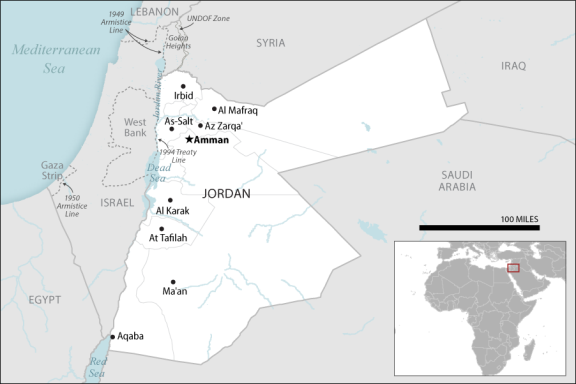 |
|
Area: 89,342 sq. km. (34,495 sq. mi., slightly larger than Indiana) Population: 10,458,413 (July 2018); Amman (capital): 2.065 million (2018) Ethnic Groups: Arabs 97%; other 2.6% (includes Armenians, Circassians) (2015) Religion: Sunni Muslim 97.2%; Christian 2.2%; Buddhist 0.4%; Hindu 0.1% Percent of Population Under Age 25: 54% (2018) Literacy: 95.4% (2015) Youth Unemployment: 40.6% (2018) |
Source: Graphic created by CRS; facts from CIA World Factbook and World Bank.
The Economy
With few natural resources and a small industrial base, Jordan has an economy that depends heavily on external aid, tourism, expatriate worker remittances, and the service sector. Among the long-standing problems Jordan faces are poverty, corruption, slow economic growth, and high levels of unemployment. The government is by far the largest employer, with between one-third and two-thirds of all workers on the state's payroll. These public sector jobs, along with government-subsidized food and fuel, have long been part of the Jordanian government's "social contract" with its citizens.
In the past decade, this arrangement between state and citizen has become more strained. When oil prices skyrocketed between 2007 and 2008, the government had to increase its borrowing in order to continue fuel subsidies. The 2008 global financial crisis was another shock to Jordan's economic system, as it depressed worker remittances from expatriates. The unrest that spread across the region in 2011 further exacerbated Jordan's economic woes, as the influx of hundreds of thousands of Syrian refugees increased demand for state services and resources. Moreover, tourist activity, trade, and foreign investment decreased in Jordan after 2011 due to regional instability.
Finally, Jordan, like many other countries, has experienced uneven economic growth, with higher growth in the urban core of the capital Amman and stagnation in the historically poorer and more rural areas of southern Jordan. According to the Economist Intelligence Unit, Amman is the most expensive Arab city and the 25th-most expensive city to live in globally.24
Popular economic grievances have spurred the most vociferous protests in Jordan. Youth unemployment is high, as it is elsewhere in the Middle East, and providing better economic opportunities for young Jordanians outside of Amman is a major challenge. Large-scale agriculture is not sustainable because of water shortages, so government officials are generally left providing young workers with low-wage, relatively unproductive civil service jobs. How the Jordanian education system and economy can respond to the needs of its youth has been and will continue to be one of the defining domestic challenges for the kingdom in the years ahead.
2018 Public Protests and International Response
Over the past year, Jordan's efforts to cut spending and raise revenue have faced significant public resistance. In 2016, the IMF and Jordan reached a three-year, $723 million extended fund facility (EFF) agreement that commits Jordan to improving the business environment for the private sector, reducing budget expenditures, and reforming the tax code. As a result, in 2017 Jordan enacted a Value Added Tax (VAT) on common goods to raise revenue in line with IMF-mandated reforms.
To comply further with IMF-mandated reforms, the Jordanian government drafted a new tax bill to increase personal income taxes and thus raise government revenue and ease the public debt burden. The draft tax bill would have lowered the minimum taxable income level in order to expand the tax base from 4.5% of workers to 10%.25 It also would have raised corporate taxes on banks and reclassified tax evasion as a felony rather than a misdemeanor.
In late May 2018, as the bill drew closer to passage and after an IMF team visited Jordan to review its economic reform plan, demonstrations began across the country. On May 30, Jordanian unions and professional associations held a massive general strike against the tax bill and were joined by many younger protesters who denounced recent price hikes on fuel and electricity. Days later, King Abdullah II ordered the government to freeze a 5.5% increase in the price of fuel and a 19% increase in electricity prices. For days, protests continued throughout the country, with some protesters calling for parliament to be dissolved and the political system to be reformed.
On June 4, Prime Minister Hani Mulki resigned, and King Abdullah II appointed Education Minister and former World Bank economist Omar Razzaz as prime minister. A change in prime minister is considered fairly routine in Jordanian politics, and protesters decried it as an insufficient response to their demands. Large-scale demonstrations continued for two more days, and on June 7 the government announced that it was withdrawing the bill from immediate consideration and sending it back to parliament for revision.
On June 11, Kuwait, the United Arab Emirates, and Saudi Arabia held a summit in Mecca, Saudi Arabia, where they collectively pledged $2.5 billion for Jordan. The aid included a $1 billion deposit at the Central Bank of Jordan. The IMF supported the Jordanian government's decision to revise the tax bill, noting that fiscal reforms should not come at the expense of political stability.26
This was not the first time that the Jordanian monarchy backtracked on reforms in the face of public pressure. In 1989, 1996, and 2012, Jordanian monarchs responded to mass demonstrations with limited political reforms (new elections and electoral laws, constitutional amendments, anticorruption measures) that did not fundamentally alter the political system. In times of crisis, the government often appeals for Jordanian unity, while calling the opposition divisive or even disloyal.27 King Abdullah II's turn toward the Gulf for a financial bailout also has precedents. In 2012, at the height of unrest in the Middle East, the Gulf Cooperation Council countries pledged $5 billion to Jordan.
|
Protests in Jordan While the government has used familiar tools in its response to protests, the protesters themselves do not necessarily fit the profile of previous demonstrations. The 2018 demonstrations were not organized by Islamists or pro-Palestinian activists focusing primarily on political grievances, but were decentralized and focused mainly on economic themes.28 Many protesters hailed from traditional strongholds of the monarchy, calling into question how King Abdullah II will be able to manage in the future if he is pressured to enact fiscal austerity measures. At the forefront of ongoing protests in Amman since 2018 have been participants in Hirak (tribal youth movements that began protesting in 2011).29 According to one account, "What makes this opposition volatile is its free-flowing, networked nature. Youth demonstrations are leaderless but come in weekly waves, with each successive protest often larger than the last as participants learn and adapt." 30 |
In fall 2018, the Jordanian government proposed a new draft tax bill which raises personal and family exemptions for the poorest citizens. The Gulf monarchies also followed through with their $2.5 billion pledge to Jordan, providing (as mentioned above) $1 billion in central bank deposits, $600 million in loan guarantees, $750 million in direct budgetary support (spread over five years), and $150 million for school construction.31 In December 2018, parliament approved final modifications to the law, and personal income tax rates were adjusted to ensure that the poorest taxpayers were not adversely affected.32
Beyond the Gulf Arab monarchies, the international community also has increased efforts to boost economic growth in Jordan. In February 2019, the United Kingdom hosted an international donor's conference for Jordan, referred to as The London Initiative 2019. At the conference, donors (UK, France, Japan, and the European Investment Bank) pledged $2.6 billion to Jordan spread over several years. At the conference, the World Bank also announced that pending final approval, it intended to provide $1.9 billion in concessional loans to Jordan over the next two years.
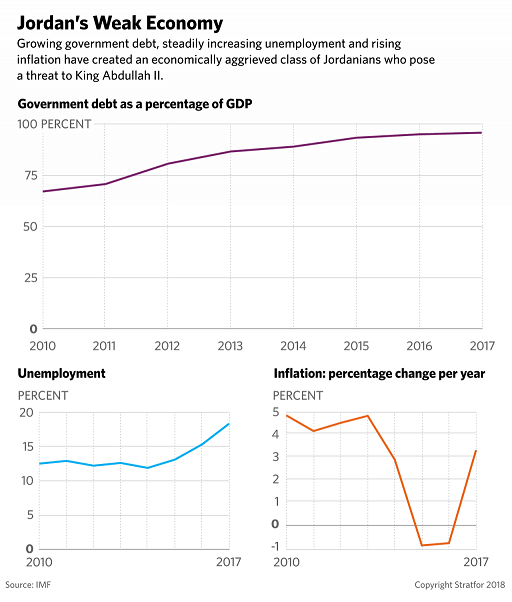 |
|
Source: Stratfor |
Syrian Refugees in Jordan
Since 2011, the influx of Syrian refugees has placed tremendous strain on Jordan's government and local economies, especially in the northern governorates of Mafraq, Irbid, Ar Ramtha, and Zarqa. Due to Jordan's low population, it has one of the highest per capita refugee rates in the world. As of March 2019, the United Nations High Commissioner for Refugees (UNHCR) estimates that there are 670,238 registered Syrian refugees in Jordan; 83% of all Syrian refugees live in urban areas, while the remaining 17% live in three camps—Azraq, Zaatari, and the Emirati Jordanian Camp (Mrajeeb al Fhood).
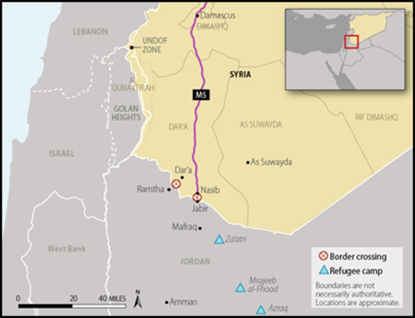 |
|
Source: CRS Graphics. Note: M5 (purple line) is the main north-south highway in Syria. |
Another 41,000 refugees are stranded in the desert along the northeastern Jordanian area bordering Syria and Iraq, known as Rukban. Though most of the refugees stranded at Rukban are women and children, a June 2016 IS terrorist attack near the border led Jordanian authorities to close the area, and access to Rukban is sporadic. In 2018, Syrian government forces reestablished control of southern Syria and often have prevented U.N. food shipments from reaching Rukban. Rukban is located within a 35-mile, U.S.-established "de-confliction zone" surrounding U.S. forces based at the At Tanf garrison near the Syrian-Iraqi-Jordanian triborder area.33
In recent months, Syrian and Russian reports have accused the United States of using refugees stranded at Rukban as "human shields" to protect the U.S. garrison at At Tanf from being attacked.34 In response, the U.S. Department of Defense issued a statement in March 2019, saying "Despite Syrian and Russian propaganda to the contrary, the United States is not restricting the movement of IDPs into or out of the camp at Rukban. The United States fully supports a process to allow IDPs freedom of movement that is free from coercion and allows for safe, voluntary, and dignified departures for those wishing to leave Rukban."35 According to the United Nations:
Discussions are ongoing with the main parties involved, including the Government of Syria, the Russian Federation, the United States and the Government of Jordan to further clarify the process and to address the concerns that have been raised by people in Rukban. The United Nations continues to reiterate the importance of a carefully planned, principled approach that ensures respect for core protection standards and does not expose vulnerable, and in many cases traumatized, displaced people to additional harm. All movements must be voluntary, safe, well-informed and dignified, with humanitarian access assured throughout. In parallel, the United Nations also continues to strongly advocate for additional humanitarian assistance for those who remain in Rukban.36
|
Triborder Area |
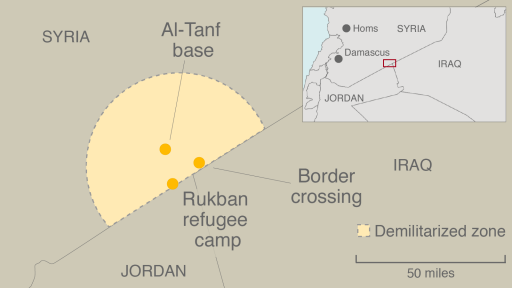 |
|
Source: Created by Public Radio International, using data from UNOSAT and the Carter Center. |
Water Scarcity and Israeli-Jordanian-Palestinian Water Deal
Jordan is among the most water-poor nations in the world and ranks among the 10 countries with the lowest rate of renewable fresh water per capita.37 According to the Jordan Water Project at Stanford University, Jordan's increase in water scarcity over the last 60 years is attributable to an approximate 5.5-fold population increase since 1962, a decrease in the flow of the Yarmouk River due to the building of dams upstream in Syria, gradual declines in rainfall by an average of 0.4 mm/year since 1995, and depleting groundwater resources due to overuse.38 The illegal construction of thousands of private wells also has led to unsustainable groundwater extraction. The large influx of Syrian refugees has heightened water demand in the north and, according to USAID, "many communities in Jordan have long experienced tensions over water scarcity even before the arrival of 657,433 registered Syrian refugees in the last five years."39
To secure new sources of fresh water, Jordan has pursued water cooperative projects with its neighbors. On December 9, 2013, Israel, Jordan, and the Palestinian Authority signed a regional water agreement (officially known as the Memorandum of Understanding on the Red-Dead Sea Conveyance Project, see Figure 5) to pave the way for the Red-Dead Canal, a multibillion-dollar project to address declining water levels in the Dead Sea.40 The agreement was essentially a commitment to a water swap, whereby half of the water pumped from the Red Sea is to be desalinated in a plant to be constructed in Aqaba, Jordan. Some of this water is to then be used in southern Jordan. The rest is to be sold to Israel for use in the Negev Desert. In return, Israel is to sell fresh water from the Sea of Galilee to northern Jordan and sell the Palestinian Authority discounted fresh water produced by existing Israeli desalination plants on the Mediterranean. The other half of the water pumped from the Red Sea (or possibly the leftover brine from desalination) is to be channeled to the Dead Sea. The exact allocations of swapped water were not part of the 2013 MOU and were left to future negotiations.
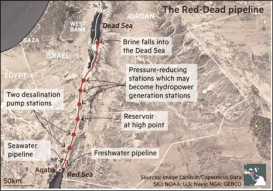 |
|
Source: Financial Times, March 22, 2017. |
In 2017, with Trump Administration officials seemingly committed to reviving the moribund Israeli-Palestinian peace process, U.S. officials focused on finalizing the terms of the 2013 MOU. In July 2017, the White House announced that U.S. Special Representative for International Negotiations Jason Greenblatt had "successfully supported the Israeli and Palestinian efforts to bridge the gaps and reach an agreement," with the Israeli government agreeing to sell the Palestinian Authority (PA) 32 million cubic meters (MCM) of fresh water.41
However, one 2018 report indicated that some Israeli officials may have had misgivings about the project and were seeking to pull out of the deal.42 According to one unnamed U.S. official cited by the report, "The United States told Israel that the U.S. supports the project and expects Israel to live up to its obligations under the Red-Dead agreement or find a suitable alternative that is acceptable to Israel and Jordan."43 In January 2019, Israel's Minister for Regional Cooperation Tzachi Hanegbi told Bloomberg News that he expects the Israeli cabinet to approve the Red Sea-Dead Sea project and that Israel and Jordan will each pledge $40 million per year to the project for 25 years.44
Congress has supported the Red-Dead Sea Conveyance Project. P.L. 114-113, the FY2016 Omnibus Appropriations Act, specifies that $100 million in Economic Support Funds (ESF) be set aside for water sector support for Jordan, to support the Red Sea-Dead Sea water project. In September 2016, USAID notified Congress that it intended to spend $100 million in FY2016 ESF-Overseas Contingency Operations (OCO) assistance on Phase One of the project.45
U.S. Relations
U.S. officials frequently express their support for Jordan. President Trump has acknowledged Jordan's role as a key U.S. partner in countering the Islamic State, as many U.S. policymakers advocate for continued robust U.S. assistance to the kingdom. Annual aid to Jordan has nearly quadrupled in historical terms over the last 15 years. Jordan also hosts U.S. troops. According to President Trump's December 2018 War Powers Resolution Report to Congress, "At the request of the Government of Jordan, approximately 2,795 United States military personnel are deployed to Jordan to support Defeat-ISIS operations, enhance Jordan's security, and promote regional stability."46
The Trump Administration has enacted changes to long-standing U.S. policies on Israel and the Palestinians,47 which Palestinians have criticized as unfairly punitive and biased toward Israel,48 and Jordan has found itself in a difficult political position. While King Abdullah II seeks to maintain strong relations with the United States, the issue of Palestinian rights resonates with much of the Jordanian population; more than half of all Jordanian citizens originate from either the West Bank or the area now comprising the state of Israel. In trying to balance U.S.-Jordanian relations with concern for Palestinian rights, King Abdullah II has refrained from directly criticizing the Trump Administration, while urging the international community to return to the goal of a two-state solution that would ultimately lead to an independent Palestinian state with East Jerusalem as its capital.49
U.S. Foreign Assistance to Jordan
The United States has provided economic and military aid to Jordan since 1951 and 1957, respectively. Total bilateral U.S. aid (overseen by the Departments of State and Defense) to Jordan through FY2017 amounted to approximately $20.4 billion. Jordan also has received hundreds of millions in additional military aid since FY2014 channeled through the Defense Department's various security assistance accounts. Currently, Jordan is the third-largest recipient of annual U.S. foreign aid globally, after Afghanistan and Israel.
|
Account |
FY2015 |
FY2016 |
FY2017 |
FY2018 |
FY2019 est. |
FY2020 Request |
|
ESF |
$615.000 |
$812.350 |
$832.350 |
$1,082.400 |
$1,082.400 |
$910.800 |
|
FMF |
$385.000 |
$450.000 |
$470.000 |
$425.000 |
$425.00 |
$350.000 |
|
NADR |
$7.700 |
$8.850 |
$13.600 |
$13.600 |
$13.600 |
$10.400 |
|
IMET |
$3.800 |
$3.733 |
$3.879 |
$4.000 |
$4.000 |
$3.800 |
|
Total |
$1,011.500 |
$1,274.933 |
$1,319.830 |
$1,525.000 |
$1,525.000 |
$1,275.000 |
Source: U.S. State Department
Notes: Funding levels in this table include both enduring (base) and Overseas Contingency Operation (OCO) funds. For FY2019, Congress made available $50 million for Jordan from the Relief and Recovery Fund (RRF).
U.S.-Jordanian Agreement on Foreign Assistance
On February 14, 2018, the United States and Jordan signed a new Memorandum of Understanding (or MOU) on U.S. foreign assistance to Jordan. The MOU, the third such agreement between the United and Jordan, commits the United States to provide $1.275 billion per year in bilateral foreign assistance over a five-year period for a total of $6.375 billion (FY2018-FY2022). This latest MOU represents a 27% increase in the U.S. commitment to Jordan above the previous iteration and is the first five-year MOU with the kingdom. The previous two MOU agreements had been in effect for three years.
Economic Assistance
The United States provides economic aid to Jordan for (1) budgetary support (cash transfer), (2) USAID programs in Jordan, and (3) loan guarantees. The cash transfer portion of U.S. economic assistance to Jordan is the largest amount of budget support given to any U.S. foreign aid recipient worldwide.50 In November 2018, USAID notified Congress that it intended to obligate a record $745 million in FY2018 ESF (base and OCO) for a cash transfer to Jordan.51 U.S. cash assistance is provided in order to help the kingdom with foreign debt payments, Syrian refugee support, and fuel import costs (Jordan is almost entirely reliant on imports for its domestic energy needs). According to USAID, ESF cash transfer funds are deposited in a single tranche into a U.S.-domiciled interest-bearing account and are not commingled with other funds.52
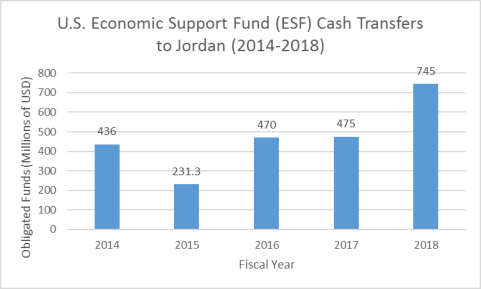 |
|
Source: CRS analysis of USAID Notifications to Congress |
USAID programs in Jordan focus on a variety of sectors including democracy assistance, water conservation, and education (particularly building and renovating public schools). In the democracy sector, U.S. assistance has supported capacity-building programs for the parliament's support offices, the Jordanian Judicial Council, the Judicial Institute, and the Ministry of Justice. The International Republican Institute and the National Democratic Institute also have received U.S. grants to train, among other groups, the Jordanian Independent Election Commission (IEC), Jordanian political parties, and members of parliament. In the water sector, the bulk of U.S. economic assistance is devoted to optimizing the management of scarce water resources. As mentioned above, Jordan is one of the most water-deprived countries in the world.53 USAID subsidizes several waste treatment and water distribution projects in the Jordanian cities of Amman, Mafraq, Aqaba, and Irbid.54
U.S. Sovereign Loan Guarantees (or LGs) allow recipient governments (in this case Jordan) to issue debt securities that are fully guaranteed by the United States government in capital markets,55 effectively subsidizing the cost for governments of accessing financing. Since 2013, Congress has authorized LGs for Jordan and appropriated $413 million in ESF (the "subsidy cost") to support three separate tranches, enabling Jordan to borrow a total of $3.75 billion at concessional lending rates.56
Humanitarian Assistance for Syrian Refugees in Jordan
The U.S. State Department estimates that, since large-scale U.S. aid to Syrian refugees began in FY2012, it has allocated more than $1.3 billion in humanitarian assistance from global accounts for programs in Jordan to meet the needs of Syrian refugees and, indirectly, to ease the burden on Jordan.57 According to the State Department, U.S. humanitarian assistance is provided both as cash assistance to refugees and through programs to meet their basic needs, such as child health care, education, water, and sanitation. According to USAID, U.S. humanitarian assistance funds are enabling UNICEF to provide health assistance for around 40,000 Syrians sheltering at the informal Rukban and Hadalat settlements along the Syria-Jordan border berm, including water trucking, the rehabilitation of a water borehole, and installation of a water treatment unit in Hadalat.
Military Assistance
U.S.-Jordanian military cooperation is a key component in bilateral relations. U.S. military assistance is primarily directed toward enabling the Jordanian military to procure and maintain U.S.-origin conventional weapons systems.58 According to the State Department, Jordan receives one of the largest allocations of International Military Education and Training (IMET) funding worldwide, and IMET graduates in Jordan include "King Abdullah II, the Chairman of the Joint Chiefs of Staff, the Vice Chairman, the Air Force commander, the Special Forces commander, and numerous other commanders."59
Foreign Military Financing (FMF) and DOD Security Assistance
FMF overseen by the State Department is designed to support the Jordanian armed forces' multiyear (usually five-year) procurement plans, while DOD-administered security assistance supports ad hoc defense systems to respond to immediate threats and other contingencies. FMF may be used to purchase new equipment (e.g., precision-guided munitions, night vision) or to sustain previous acquisitions (e.g., Blackhawk helicopters, AT-802 fixed-wing aircraft). FMF grants have enabled the Royal Jordanian Air Force to procure munitions for its F-16 fighter aircraft and a fleet of 28 UH-60 Blackhawk helicopters.60
As a result of the Syrian civil war and U.S. Operation Inherent Resolve against the Islamic State, the United States has increased military aid to Jordan and channeled these increases through DOD-managed accounts. Although Jordan still receives the bulk of U.S. military aid through the FMF account, Congress has authorized defense appropriations to strengthen Jordan's border security. Since FY2015, total DOD security cooperation funding for Jordan has amounted to $887.7 million.61
Excess Defense Articles
In 1996, the United States granted Jordan Major Non-NATO Ally (MNNA) status, a designation that, among other things, makes Jordan eligible to receive excess U.S. defense articles, training, and loans of equipment for cooperative research and development.62 In the last five years, excess U.S. defense articles provided to Jordan include two C-130 aircraft, HAWK MEI-23E missiles, and cargo trucks.